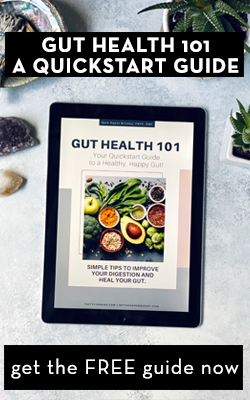What are Endocrine Disruptors and How to Avoid Them? In the spirit of always reminding you that the health of our body goes beyond the food we eat and the supplements we take, I want to take some time to share more about endocrine disrupting chemicals and why you should care. Hormone disruptors can affect the health of our body as much as the food we eat and they can be found not just in our food, but in our skincare and cosmetics, household cleaning products, furniture and more. It can be overwhelming and scary to think about, but I think knowing what they are and why it matters – is the first step to being informed and empowered!
Before we get into the harmful chemicals the have been shown to interfere with development and reproduction, and may cause serious neurological and immune system effects, I think it’s first really important to go back to basics and chat about what the endocrine system is and the roles it plays in our overall health.
What is the Endocrine System?
The endocrine system is comprised of a network of hormones (chemical messengers produced and used by the body) and glands that coordinate and regulate many essential body functions such as:
- Growth, development and maturation.
- Metabolism.
- Behavior.
- Reproduction and embryo development.
- Production, use and storage of energy.
- Balance and maintenance of water and salt (electrolytes) in the body.
- Reaction to stimuli (e.g., fright, excitement).
The endocrine system includes the ovaries; the testes; the thyroid, parathyroid, adrenal, and pituitary glands; the pineal body; the pancreas; as well as cells releasing hormones found in the gastrointestinal tract, kidney, heart and placenta.
As you can assume, altering these precise and delicate systems in any way can certainly be “playing with fire”, but yet it can happen quite easily on a day-to-day basis when you use “normal” everyday products in your home. Part of what makes endocrine disruptors so threatening is their ubiquitous nature and the fact that for most of us we are exposed to many of these chemicals on the daily.
(video from The Endocrine Society)
What are Endocrine Disruptors and Why Should You Care?
It may be a term you have heard in passing, maybe in regards to plastic bottles or chemicals in your household cleaning products, in our water or food supply. But it can all be confusing. What are the biggest offenders we should be avoiding immediately, where should we begin when trying to clean up our home and personal products, how worried should we be?
Endocrine disruption is, simply, any disturbance in the proper functioning of hormones in the body due to chemical exposure. Endocrine Disruptors (EDs) or Endocrine Disrupting Chemicals (EDCs) are defined as an exogenous chemical, or mixture of chemicals, that an interfere with any aspect of hormone action.
The many ways that endocrine disruptors can wreak havoc on our bodies in unending, interfering with the steps in hormone signaling from increasing the production of certain hormones to decreasing production of others. Some chemicals can mimic hormones by binding to receptors; they can turn one hormone into another; cause too much of a hormone to be produced or released and in some cases they can interfere with hormone signaling blocking the activation of a hormone causing too little of a natural hormone to be produced or circulated. Additionally some chemicals can tell cells to die prematurely; compete with essential nutrients; binding to essential hormones preventing appropriate hormonal processes from taking place; accumulating in organs that produce hormones and so on.
In fact, the data linking some EDCs or entire classes of EDCs to chronic disease is comparable in strength and breadth to the evidence that links tobacco smoking with lung cancer.
Commonly we know these chemicals to be found in common household items like plastics and food packaging, fragrances, personal care products, pesticides or herbicides found in food and even our tap water.
One of the greatest challenges is that EDCs are all around us and have been for decades and they are not easy to avoid. The annual global production of plastics has grown from 50 million tons to 300 million since the 1970s. This surge in manufacturing in the United States, European Union, China, and elsewhere has contributed to the addition of thousands of new chemicals into our environment—ones that haven’t been tested for safety.
These chemicals can leach into our soil and water. They can move through the animal kingdom as animals eat plants and bigger animals eat smaller ones. Once in our environment, EDCs can enter our own bodies through eating, drinking, or breathing, and can even be transferred from mother to fetus or infant.1https://www.endocrine.org/topics/edc/what-edcs-are
Studies indicate that nearly all people have a detectable level of EDCs in our blood, urine, placenta, or other body tissues. This means that we cannot completely avoid or remove EDCs, but what we can do is make informed choices about our exposure to reduce the effects on our health.
In 2015, the Endocrine Society analyzed 1,800 studies on EDCs and published an evidence-based scientific statement. They found clear evidence showing how EDCs disrupt our hormones and harm our health. They are linked to male and female reproductive disorders, obesity, diabetes, neurological problems, immune and thyroid disorders, osteoporosis, Parkinson’s disease, and hormone-related cancers.

A very simple way to think about the most common endocrine disruptors…
THE FOUR Ps: Pesticides, Plastics, Perfumes, Phthalates, Pesticides
A Few of the Most Common Endocrine Disrupting Chemicals:
- BPA – Bisphenol A. The synthetic chemical found in the lining of food and beverage cans as well as thermal paper receipts, most commonly known as an estrogen mimicker. This synthetic hormone can trick the body into thinking it’s the real time and the results are terrifying. BPA has been linked to everything from breast and other cancers to early puberty, reproductive issues, obesity and more. Government testing has been that more than 90% of ALL Americans have BPA in their bodies. HOW TO AVOID: Common places BPA is found, lined canned foods. Plastics labeled PC (polycarbonate), those with the recycling symbol with the #7 and many thermal paper receipts are coated with BPA.
- Dioxin. Industrial solvents or lubricants and their byproducts can disrupt the very delicate signaling processes with the male and female sex hormones. Exposure, even at low levels in the womb can permanently effect sperm count in men during their reproductive years and has been linked to endometriosis in women. Dioxins can build up in the body and affect the immune system in addition to the reproductive system. Agent Orange made dioxin infamous in the 1980s. Dioxin is present in every aspect of life: water, air, soil and food. Dioxins can also be found in the food supply, due to contamination from industrial sources. HOW TO AVOID: Overall, due to the ubiquitous nature of dioxin, it can be one of the harder endocrine disruptors to avoid, but limiting or avoiding animal products that are factory farmed or derived from CAFO (Confined Animal Feeding Operations) is a step in the right direction. This is ESPECIALLY important when consuming animal fats. Animals store dioxin and other toxins in their fat, (as do we) if you aren’t sourcing quality meats, at the very least avoid the fat. Eat organic fruits and vegetables. When gardening, avoid using pesticides and herbicides that contain dioxin. Avoid bleach, which form dioxin after contact with organic compounds. In personal care products, avoid triclosan, an antibacterial agent. It degrades into dioxin. Finally, avoid bleached coffee filters, as well as disposable diapers, napkins, tissue and paper towels, dioxin is a byproduct of the bleaching process.
- Phthalates – You’ve heard me mention this one before, in the dirty dozen of skincare and cosmetics. Phthalates have been linked to hormone changes, lower sperm count, less mobile sperm, birth defects in the male reproductive system, obesity, diabetes and thyroid irregularities. Phthalates are a class of plasticizing chemicals used to make products more pliable or to make fragrances stick to skin. HOW TO AVOID: Avoid plastic storage containers, plastic wrap made from PVC and the recycling symbol #3 (this means phthalates) and children’s toys (though some phthalates have been banned from kid’s toys, already. Phthalates are often found in synthetic fragrance, nail polish, hairspray, deodorants and other personal care products. Read the labels and avoid products that simply list added “fragrance,” this catch-all term can often mean it contains hidden phthalates.
- Flame / Fire Retardants – These incredibly persistent chemicals, known as polybrominated diphenyl ethers or PBDEs, have since been found to contaminate the bodies of people and wildlife around the globes. These chemicals can imitate thyroid hormones and disrupt their activity. That can lead to lower IQ, among other significant health effects. Several kinds of PBDEs have now been phased out, but this doesn’t mean that toxic fire retardants have gone away. PBDEs are incredibly persistent, so they’re going to be contaminating people and wildlife for decades to come. HOW TO AVOID: These chemicals are found in building materials and electronics, plastics used furniture (sofas and beds), wire insulation, foam used in car seats and carpet. Flame retardant chemicals can also be found in children’s toys, clothing and other products.
- Perfluorinate Chemicals (PFCs) – Perfluorinate chemicals are most commonly used to create non-stick cookware. So widespread, these chemicals are found in the bodies of 99% of Americans. PFOAs are a notorious chemical used in Teflon and interfere with thyroid hormone binding. Affects have been seen not just in brain development, but fetal growth and birth weight. While PFCs and PFOAs have been phased out of use in manufacturing plants after decades of use, PFOAs have been shown to be completely resistant to biodegradation, by not breaking down in their environment, their affects and presence will be seen for decades to come and water contamination is still prevalent across the country. HOW TO AVOID: Skip non-stick pan, do not cook in old Teflon pans and avoid stain and water-resistant coatings on clothing, furniture and carpets.
- Organiphosphate Pesticides and Other Pesticides and Herbicides – Atrazine, Glyphosate, DDT etc. – These neurotoxic organophosphate compounds were originally produced by the Nazis in huge quantities for chemical warfare during World War II, but thankfully were never used. However, these same chemistry was used by American scientists to develop a long line of pesticides that target the nervous systems of insects, pests, rodents and microorganisms. Despite many studies linking organophosphate exposure to brain development, behavior and fertility, fetal development and more they are still among the more common pesticides in use today. A few of the many ways that organophosphates can affect the human body include interfering with the way testosterone communicates with cells, lowering testosterone and altering thyroid hormone levels. You can read more specifically about glyphosate in this article I wrote here. HOW TO AVOID: Choose organic vegetables and use Environmental Working Group’s Shopper’s Guide to Pesticides in Produce, to find the fruits and vegetables that have the fewest pesticide residues. Please also read this article about atrazine contaminating drinking water for millions of Americas.
Check out the EWG’s Dirty Dozen List of 12 Hormone-Altering Chemicals and How to Avoid Them, a more comprehensive list. You can also learn more about the most common EDCs and their uses, so you can educate yourself on what to be looking for and avoiding and check out the Dirty Dozen list of Endocrine Disruptors from EWG. Remember, EDCs come from many different sources, people are exposed in several ways, including the air we breathe, the food we eat, and the water we drink. EDCs can also enter the body through the skin. Check out the DIRTY DOZEN list of harmful ingredients I suggest to look out for in personal care products.
What Can You Do?
- Choose Organic Whenever Possible. Non-organic produce can contain pesticide residue. Organic or not, always be sure to properly wash your produce well to remove as much chemicals or residue, as possible. There is however no washing method that is 100% effective for removing ALL pesticide residues. Leafy greens and vegetables are the foods for which eating organic matter the most, because you are eating the part of the plant of which the pesticides and herbacides were sprayed. Learn more about the dirty dozen and clean 15 of produce. When choosing meats, grass-fed, free range, organic can help to reduce your exposure to added hormones, pesticides, and fertilizers
- Read the Labels. On plastic bottles, a #1, #2, or #4 in the recycling sign means that the product is free of BPA, a still commonly-used EDC. Avoid canned foods and foods packaged in hard polycarbonate plastics (typically those with the numbers 3,6 and 7 in the recycling triangle on the bottom are considered to be unsafe across the board). Shower curtains, raincoats, flooring, and outdoor furniture will be similarly labeled for PVCs, as will canned food with BPA-free liners. Labels for cleaning supplies, facial washes, lotions and cosmetics and detergents also indicate the presence or absence of some EDCs known to be a potential risk, such as phthalates – read more about the DIRTY DOZEN list of harmful ingredients I suggest to look out for in personal care products.
- Opt for Fresh, Whole Real Foods. Limit processed foods. Processed foods can accumulate traces of EDCs that leached out of materials used in manufacturing, processing, transportation, and storage process.
- Choose Wild Caught Fish. Conventional or farm-raised fish are often heavily contaminated with PCBs and mercury.
- Choose Filtered Water as opposed to bottled or tap water. Check out the EWG Water Filter Guide. Don’t forget to change your water filters on time. Old filters can harbor bacteria and let contaminants through.
- Skip the Plastic Storage Containers and be mindful of leaching. Canned and plastic packaged foods should NEVER be exposed to heat. Do not leave in a hot car. Do not microwave or heat food in plastic containers. Carry your water in safe containers. Plastic bottles can leach harmful chemicals into your water. Carry stainless steel or shatter-proof glass bottles. Don’t reuse single-use water bottles. The plastic can harbor bacteria and break down to release chemicals. Do not wash plastic in the dishwasher. EDCs can leach out of the container and into your food and body. While we’ve heard about BPA-free products, BPP, BPF, BPS, BPZ, and BPAP are alternatives which pose similar if not worse threats. It’s best to avoid polycarbonate plastic containers altogether.
- Avoid Thermal Paper Receipts. Say no to the coated receipts at the registers, they contain bisphenol A (BPA)
- Open Your Windows for Circulation and Clean Your Home Regularly. Outdoor air has lower concentrations of flame-retardants, recirculating the air in your home helps to get rid of chemical residues. Vacuuming and mopping with a wet mop regularly helps to prevent contaminated dust from accumulating.
- Replace Your Non-Stick Pots and Pans with cast iron or stainless plans, along with ceramic or glass cookware.
- Avoid Artificial Fragrance, often found in air fresheners, dryer sheets, fabric softeners, or other synthetic fragrances. Look for products that are fragrance-free. One artificial fragrance can contain hundreds – even thousands – of potentially toxic chemicals.
- Avoid Soy. Soy-based products contain phytoestrogens, which are chemicals produced by plants that mimic estrogen.
- Contact the EPA to demand a complete ban on atrazine and sign the petition for the EPA to ban glyphosate.
Learn More. Stay Informed. Do Your Research. Some Additional Resources for You:
Sicker, Fatter, Poorer: The Urgent Threat of Hormone-Disrupting Chemicals to our Health and Future…and What We Can Do About It by Leonardo Trasande MD MPP
Environmental Working Group has important advice for reducing your exposure to EDCs, and the Pediatric Environmental Health Toolkit is useful for all parents as well as healthcare providers. Check out the EWG’s Dirty Dozen List of 12 Hormone-Altering Chemicals and How to Avoid Them
You can use the EWG consumer guides and product database to search for various products, from their Skin Deep Guide for choosing cosmetics and skincare along with their new EWG Verified™ database of products. Check out their Guide to Healthy Cleaning to check household cleaners and their ratings. For common household products, check out the Healthy Living Home Guide, to learn about potential harmful chemicals in carpet, paint, building products, furniture and more.
For food, you can use the EWG’s Food Scores database. As well, their Dirty Dozen and Clean 15 lists are updated yearly and give you incite in which fruits and vegetables are most important to choose organic
EWG Healthy Living Mobile App check out ratings for more than 120,000 food and personal care products. Scan the product, read it’s rating, make the best and safest choice.
Think Dirty – Shop Clean App – learn about ingredients in your beauty, personal care and household products. Just scan the product barcode and Think Dirty will give you easy-to-understand info on the product, its ingredients, and shop cleaner options!
Eat Wild – locate grass-fed, pasture-raised meat and dairy products.
Eat Well Guide – search over 25,000 hand-picked restaurants, farms, markets and other sources of local, sustainable food.
You are OVERWHELMED – I KNOW. It’s a lot! So, Where Do You Start?
As you start to investigate your products and foods, it can be overwhelming and scary. Don’t try to change or remove everything all at once. It’s not realistic and it’s expensive. Start with a few products at a time, maybe the worst offenders. As something else runs out, replace it with a safer option. Continue making your way through your house. Do what you can, when you can. It’s not a race!

My Recommendations for Safer Products:
Cleaning Supplies (all purpose spray, bathroom cleaner, glass cleaner): Branch Basics –(Use Code “Tasty15” to save 15% on ALL starter kits.) You can also make your own All- Purpose Cleaner
Laundry: Branch Basics – (Use Code “Tasty15” to save 15% on ALL starter kits.) Lil Green Wagon is another brand that trust.
Handsoap – Beautycounter or Branch Basics – (Use Code “Tasty15” to save 15% on ALL starter kits.)
Cosmetics and Skincare: As you know by now, all of my makeup and most of my skincare comes from Beautycounter. I also use several of EvanHealy and Primally Pure’s products as part of my skincare regimen. I also love Body Deli and Fatco’s products for body. You can read more about my skincare regimen here.
Deodorant: I recommend both Primally Pure and if you are sensitive to baking soda (which I am) I recommend Smarty Pits’ Baking Soda Free formula
Shampoo & Conditioner: I am personally in the process of sampling and switching over to Beautycounter’s hair products, I also like Desert Essence, Mineral Fusion, Andalou (though I cannot 100% guarantee these three are “perfect”)
Toothpaste: I use Redmond Earthpaste and their activated charcoal pastes, I have also heard really great things about Primal Life Organics.
Sunscreen: Countersun Mineral Sunscreen Mist or Lotion and Mineral Sunscreen Stick (for Face), Daily wear: Dew Skin Tinted Moisturizer with SPF 20
Safer Scents for the Home: I love to make my own Essential Oil Room Sprays, I diffuse Plant Therapy 100% Pure Essential Oils and I love Juniper Ridge essential oil based sprays, oils and candles.
References
| 1. | ↑ | https://www.endocrine.org/topics/edc/what-edcs-are |











